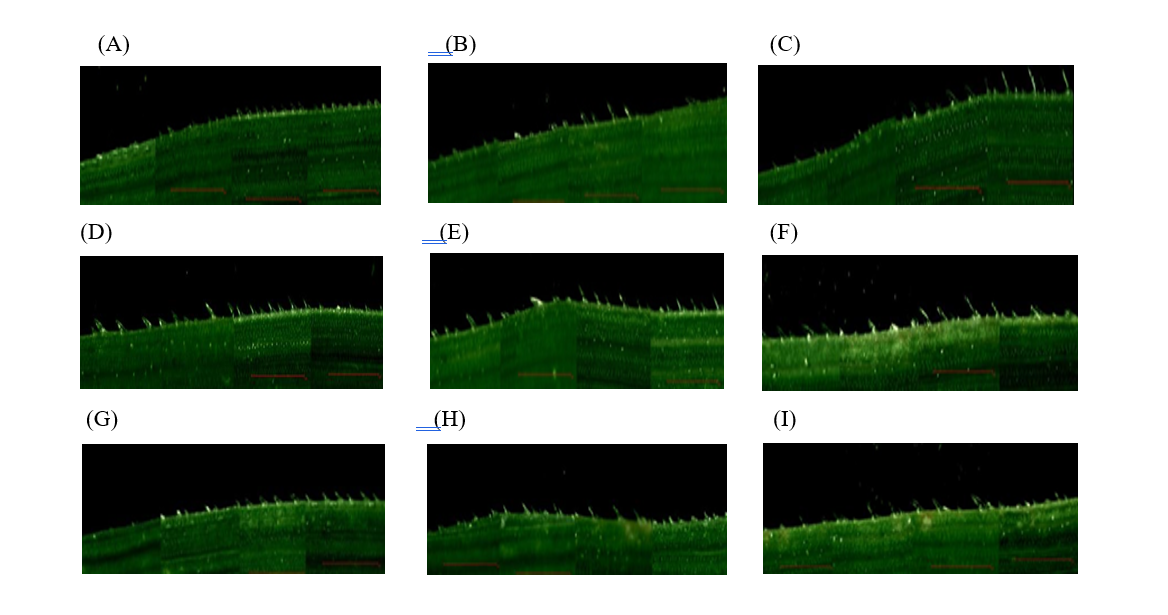
Araya Srisuwan
Department of Soil Science, Faculty of Agriculture at Kamphaeng Saen, Kasetsart University, Kamphaeng Saen Campus, Nakhon Pathom, Thailand
Aunthicha Phommuangkhuk
Department of Soil Science, Faculty of Agriculture at Kamphaeng Saen, Kasetsart University, Kamphaeng Saen Campus, Nakhon Pathom, Thailand
Suphachai Amkha
Department of Soil Science, Faculty of Agriculture at Kamphaeng Saen, Kasetsart University, Kamphaeng Saen Campus, Nakhon Pathom, Thailand
Keywords: Hydroponic system Rice growth Tiller number Trichome number
Abstract
Silicon (Si) is a beneficial element for plant growth, even though it is not considered an essential nutrient. Si plays a crucial role in strengthening plant structures, improving resistance to pests and diseases, and enhancing stress tolerance. The present study investigates the effects of calcium silicate from steel-making slag as a Si source on the plant growth, leaf thickness, number of trichomes, yield, and silicon content of rice (RD 49 variety) grown in a nutrient solution by the deep water technique. The experiment was conducted with a completely randomized design (CRD) with ten replications and nine treatments using nutrient solutions of 0.0, 0.1, 0.5, 1, 5, 10, 50, 100, and 500 mg CaSiO3/L. The results indicate that CaSiO3 concentrations of 10, 50 and 100 mg/L could promote rice growth and yield of rice. CaSiO3 concentrations of 50 and 100 mg/L effectively increased the cutin layer thickness. Additionally, the 100 and 500 mg/L CaSiO3 concentrations in the nutrient solution by the deep water technique were found to enhance the Si content in leaves, stem, and husk in rice. These findings suggest that CaSiO3 at concentrations of 50 and 100 mg/L can better promote a good yield and increased leaf thickness of rice (RD 49 variety) grown in a nutrient solution using the deep water technique.
How to Cite
Srisuwan, A. ., Phommuangkhuk, A. ., & Amkha, S. (2025). Silicon source from calcium silicate of steel making slag on leaf thickness, trichomes number, yield and silicon content in rice RD 49 variety grown under nutrient solution by deep water technique system. Asia-Pacific Journal of Science and Technology, 30(06), APST–30. https://doi.org/10.14456/apst.2025.94
References
Ma JF, Miyake Y, Takahashi E. Silicon as a beneficial element for crop plants. Stud Plant Sci. 2001;8:17–39.
Liang Y, Nikolic M, Bélanger R, Gong H, Song A. Silicon uptake and transport in plants: Physiological and molecular aspects. In: Silicon in agriculture. Silicon. 2015;10: 69–82.
Ma JF. Role of silicon in enhancing the resistance of plants to biotic and abiotic stresses. Soil Sci Plant Nutr. 2004;50:11-18.
Cooke J, Leishman MR. Is plant ecology more siliceous than we realise. Trends Plant Sci. 2011;16: 61-68.
Guntzer F, Keller C, Meunier JD. Benefits of plant silicon for crops: A review. Agron. Sustain. Dev. 2012;32:201-213.
Bockhaven JV, Vleesschauwer D, Hofte M. Towards establishing broad-spectrum disease resistance in plants: Silicon leads the way. J Exp Bot. 2013;64:1281-1293.
Pontigo S, Ribera A, Gianfreda L, Mora ML, Nikolic M, Cartes P. Silicon in vascular plants: uptake, transport and its influence on minerals stress under acidic conditions. Planta. 2015;242:23-37.
Xue Y, Wang J, Zhang L. Transformation and utilization of silicon in steel-making slag. Metall Mater Trans. 2019;50(3):678-690.
Ning D, Song A, Fan F, Li Z, Liang Y. Effects of slag-based silicon fertilizer on rice growth and brown-spot resistance. PLOS one. 2014;10:0102681.
Siriruang P, Thaymuang W, Mala T. Effects of calcium silicate on growth and yield of Phatumthani 80 rice in saline soil. Khon Kaen Agr J. 2017;45(1):991-996.
Sreenivasan ST, Prakash NB. Evaluation of calcium silicate, rice hull and rice hull ash as silicon sources in wetland rice in acidic and alkaline soils. J Indian Soc Soil Sci.2017; 65(4):428-434.
Amkha S, Rungcharoenthong P. Effect of calcium silicate on number of trichomes, leaf thickness and chlorophyll in tomato. Acta Hortic. 2021;13:1-2.
Phommuangkhuk A, Amkha S, Osotsapar Y. Effects of Si application on growth, yield and Si concentration in rice under nutrient solution system. J Agri Sci Manage. 2020;3:70-80.
Epstein E. Silicon. Annu Rev Plant Physiol Plant Mol Biol. 1999;50(1):641–664.
Asher CJ. Plant nutrition I: Practical notes. Australia: Department of Agriculture, University of Queensland. 1975;2:35-39.
Nayer PK, Misra AK, Patnaik S. Rapid micro-determination of silicon in rice plant. Plant Soil. 1975;10:491-494.
Ma JF, Yamaji N. Functions and transport of silicon in plants. Cell Mol Life Sci. 2006;63(6):701-711.
Chaiwong N, Prom-u-thai C. Significantly for improving crop productivity and factors affecting silicon uptake and accumulation in rice: a review. J Soil Sci Plant Nutri. 2022;22:1970-1982.
Ju S, Wang L, Zhang C, Tingchae Y, Shao S. Alleviatory effects of silicon on the foliar micromorphology and anatomy of rice (Oryza sativa L.) seedling under simulated acid rain. PLoS One. 2017;15:0187021.
Yoshida S. Fundamentals of rice crop science. Los Baños (Philippines): Int Rice Res Inst. 1981;2:269-270.
Korndorfer G, Lepsch I. Effect of silicon on plant growth and crop yield. In: Datnoff LE, Snyder GH, Korndörfer GH, editors. Silicon in agriculture. Amsterdam: Elsevier. 2001;8:133–147.
Ma JF, Yamaji N. Silicon uptake and accumulation in higher plants. Trends in Plant Science. 2006;11(8): 392–397.
Fallah A, Osko T, Khosravi V, Mohammadian M, Rosttami M. Reduction of chemical pesticides by using of silicate fertilizer in paddy fields. In proceedings of the 5th international conference on silicon in Agriculture. Beijing, China. 2011;46:13-18.
Soundararajan P, Manivannan N, Muneer S. Silicon enhanced photosynthetic pigments and rice productivity. Biol Trace Elem Res. 2014;161(3):364–371.
Sommer M, Bossche H. Silicon fertilizers: Potential use of steel slag. Agron Sustain Dev. 2011;31(2):301–308.
Haynes RJ. A contemporary overview of silicon availability in agricultural soils. Environ Geochem Health. 2014;36(5):913–929.

Published: Nov 4, 2025
License
This work is licensed under a Creative Commons Attribution-NonCommercial-NoDerivatives 4.0 International License.
